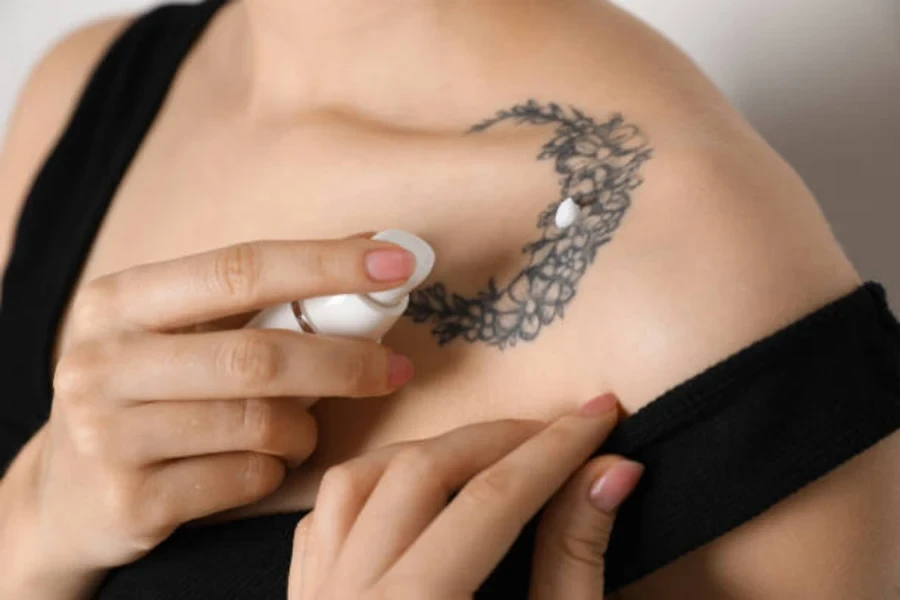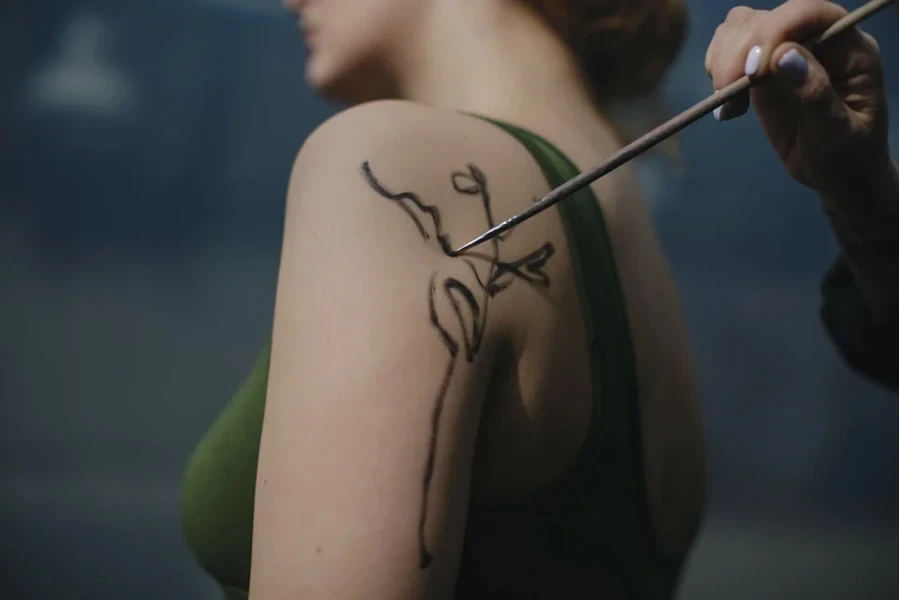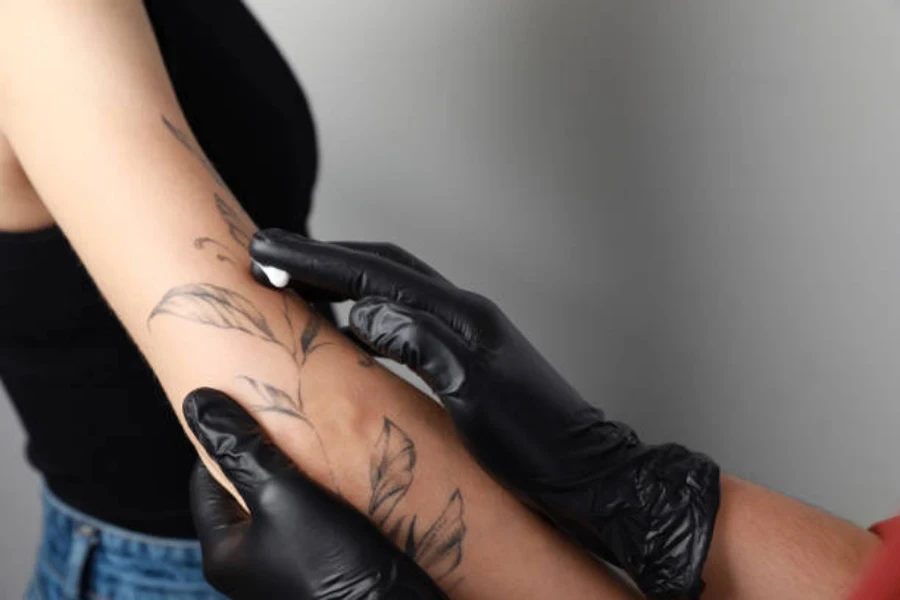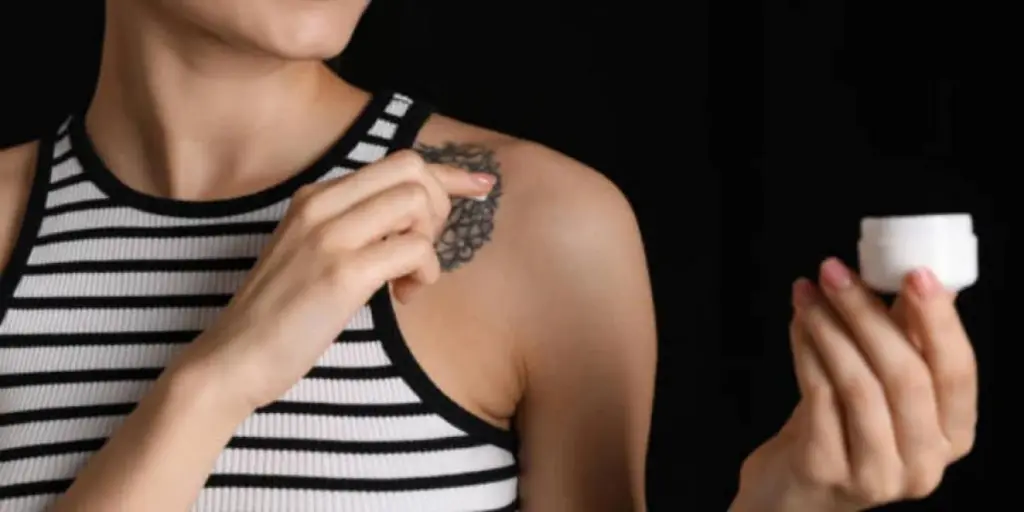Tattoos are more prevalent than ever, especially among Millennials and Gen Z, leading to rising demand for specialty products that care for inked skin. A recent report predicts the global tattoo aftercare market will reach nearly $4 billion by 2030. While most current offerings target tattoo artists, there is a whitespace opportunity around accessible at-home maintenance items. As the number of tattoos continues to grow, skintelligent consumers want solutions that preserve artistic investments. Formulations that leverage cosmetic and skin health claims show particular promise in this emerging category. In just a few sentences, this introduction establishes the rising demand, gaps in the market, and opportunities for beauty brands.
Table of Contents:
1. Consumers craving targeted tattoo care solutions
2. Healing heroes: Tattoo aftercare essentials
3. Preserve the ink: Maintenance must-haves
4. 4 ways brands can capture this category
5. Final words
Consumers craving targeted tattoo care solutions

As tattoos shift further into the mainstream, everyday consumers are seeking out products specifically formulated to care for their ink. Key factors driving this demand include changing generational attitudes, social media, and a focus on longevity and protection.
Tattoos have transitioned from taboo to trendy, especially among Millennials and Gen Z. A 2020 Harris poll found that over 50% of Millennials have at least one tattoo. With negative stereotypes fading, more consumers view tattoos as a form of self-expression. Social media has played a major role, allowing tattoo artists to rapidly grow massive followings. Fans eagerly book appointments with celebrity artists like Doctor Woo who boast over 1.7 million Instagram followers.
While inspiration thrives online, longevity remains top of mind offline. Consumers understand that sun exposure, friction, and aging can cause tattoos to fade or blur over time. As a result, they want products that preserve and protect their meaningful (and often costly) ink. Targeted skin care that maintains vibrancy is in high demand.
In sum, society’s shifting attitude toward tattoos combines with social media and preservation concerns to drive consumer interest in specialized care. As more brands enter this blossoming category, portfolio diversification and product personalization will be key differentiation strategies. Formulations catered to inked skin present an exciting innovation avenue.
Healing heroes: Tattoo aftercare essentials

The initial post-tattoo phase focuses on healing and protection against infection as the skin repairs itself. Consumers want gentle yet effective formulations that aid the healing process at home.
Cleansing is critical to avoid bacteria that can complicate healing. Antibacterial soaps gently wash away plasma, blood, and excess ink. Next, moisturizing balms create a protective barrier while delivering skin-soothing ingredients like vitamin E, aloe vera, and plant oils. These balms not only hydrate fresh tattoos but also alleviate inflammation and itching.
Since portability is key, brands offer travel-friendly formats to apply balms on the go. L:A Bruket’s After Care balm comes in a recyclable aluminum tube, while Mad Rabbit’s balm stick allows mess-free application. Consumers also want products that easily integrate into existing routines. Tattoo body washes promote healing through gentle cleansing and hydration.
Overall, aftercare essentials aid the vulnerable healing stage via antibacterial cleansing paired with protective hydration. Portable formats and everyday body care items promote routine integration. As more consumers embark on tattoo journeys, caring for fresh ink themselves with dedicated products will continue rising in popularity.
Preserve the ink: Maintenance must-haves

Once healed, the priority shifts to ongoing maintenance to preserve tattoo integrity and vibrancy. Consumers want products that protect from fading while making tattoos look freshly inked.
Exposure to sun, pollution, and friction gradually extract pigment from skin over time. Specialized formulas counteract these effects with brightening agents and antioxidants. Daily moisturizers hydrate while enhancing vibrancy, whereas serums packed with AHAs gently resurface dull-looking ink. Targeted SPF protection creates a mineral barrier against UV tattoo damage.
Brands also leverage the familiar lexicon of skin care to promote routine integration. For example, Stories & Ink structures tattoo maintenance across day and night products. Their Brightening Exfoliator aligns with existing regimens as a weekly treatment step. Simplicity helps products seamlessly fit within current rituals.
Overall, maintenance items allow consumers to safeguard tattoo integrity for the long haul. Leveraging familiar skin care terminology and formulations enables accessibility while underscoring how maintenance helps honor tattoo artistry. As ink continues rising in popularity, caring for it beyond the initial heal will attract consumer investment.
4 ways brands can capture this category

With this fledgling category demonstrating strong growth potential, how should brands look to capture this opportunity? Here are 4 key strategic plays:
Spotlight diversity and inclusion. Ink expressing cultural traditions remains prevalent globally. Ensure products suitably cater to needs across skin tones and types. Conduct specialized clinical testing on requirements such as minimizing keloids.
Co-create with artists. Collaborations, especially with influential tattooers boasting devoted followings, can really bolster credibility. Such partners lend their expertise around formulation and messaging. Their stamp of approval resonates loudly with loyal clientele.
Travel-ready formats. Portability reigns supreme within aftercare. Single use packets, rollerballs, and pens promote on-the-go application after new ink or before sun exposure. The ease of tossing products into carry-ons appeals greatly.
Embedded ritual integration. Maintaining tattoos should intertwine seamlessly into daily routines, not create additional steps. Consider how current product formats like body washes could absorb care ingredients. Promote adoption through familiar self-care rituals.

These four strategies provide diverse innovation springboards to explore within the blossoming tattoo aftercare space. Which approach most aligns with your brand identity and capabilities? Now is the time to assess portfolio fit.
Final words
As tattoos continue permeating mainstream culture, demand rises for specialized products that care for and maintain inked skin. An emerging category now exists for accessible, consumer-friendly aftercare targeting tattoo longevity. However, many whitespace opportunities remain for beauty brands seeking differentiation. By emphasizing inclusion, travel-ready formats, artist collaborations, and ritual-friendly integration, companies can craft compelling solutions. While still in its infancy, the tattoo aftercare segment shows substantial room for growth, innovation, and creative branding. The key is identifying unmet consumer needs around preserving artistic expression. Brands that solve for tattoo care priorities stand primed to ink their position within this promising space.




